Quantum Computation-Based Image Representation, Processing Operations and Their Applications
Abstract
:1. Introduction
- In Section 2, the basic knowledge and notations used in this paper are introduced first. In addition, the flexible representation of quantum images (FRQI), the general framework of all geometric transformations on FRQI quantum images and the efficient color transformations on FRQI quantum images are reviewed.
- In Section 3, the extension of FRQI quantum images that allows for processing color images, the multi-channel representation for quantum images (MCQI) is introduced. What is more, quantum circuits to realize color operations on the channel of interest, channel swapping and α blending of MCQI quantum images are presented.
- In Section 4, a method to compare multiple pairs of FRQI quantum images in parallel is discussed, where the similarities of the images are estimated through the probability distributions of the readouts from quantum measurements. It offers a significant speed-up in comparison to performing the same task on traditional computing devices by transforming multiple images in a strip simultaneously.
- In Section 5, an FRQI quantum image searching method is presented based on the parallel comparison method introduced in Section 4. It is achieved by using low computational resources, which are only a single Hadamard gate combined with m + 1 quantum measurement operations.
- In Section 6, we build on the pioneering watermarking and authentication strategy for FRQI quantum images, WaQI, to propose protocols that would facilitate the notion of watermarking MCQI color images. The proposed MC-WaQI is a double-key and double-domain watermarking strategy that is secure and flexible by utilizing QFT techniques and quantum measurements to watermark MCQI quantum images.
- In Section 7, similarly, the pioneering attempt to represent and produce movies on quantum computers (quantum movie) is extended to the multi-channel color image framework. Following this, we describe a video encryption and decryption protocol on quantum computers based on color information transformations on each frame.
- In Section 8, we conclude with some remarks on possible technologies and directions that practitioners in the area opine could be used to realize some of the FRQI-based frameworks reviewed in earlier sections. Finally, we offer a few concluding remarks.
2. A Flexible Representation of Quantum Images and Its Processing Operations
2.1. Quantum Bits and Quantum Gates
2.2. Flexible Representation for Quantum Images
Theorem 1
2.3. Fast Geometric Transformations on FRQI Quantum Images
2.4. Efficient Color Transformations on FRQI Quantum Images
3. Multi-Channel Quantum Images and Related Operations
3.1. Multi-Channel Representation for Quantum Images
- MCQI representation provides a solution using many fewer qubits to encode R, G and B channel information in normalized quantum states.
- MCQI makes it easier to design color image operators with much lower complexity.
- MCQI representation offers the potential possibility to design a quantum-cryptography-based color image watermarking algorithm.
3.2. Channel of Interest Operator
3.3. Channel Swapping Operator
3.4. The α Blending Operator
4. Parallel Comparison of Multiple Pairs of FRQI Quantum Images
4.1. Representation of Strip Encoding Multiple FRQI Images
Definition 1
4.2. Scheme to Compare Images in Parallel on Quantum Computers
Definition 2
Definition 3
- Preparation of the strip comprising 2m quantum imagesThe quantum images are prepared into FRQI states using their classical versions images. The color information, as well as the corresponding positions of every point in the classical version are integrated into the quantum state, and the 2m quantum images being compared are combined to form a vertically-oriented strip. The routine involved in preparing FRQI quantum images and its extension to encode multiple FRQI quantum images as a single register, called the strip, are discussed thoroughly in [12,21,36].
- Comparison of quantum images through quantum operationsThe strip as prepared in the preceding period is transformed using geometric transformations [29] on all of the images in the strip. This transformation step combines with measurement operations that follow it to convert the quantum information into the classical form as probability distributions. Since measurements are known to destroy the superposition state in quantum systems [15], the strip has to be prepared n (n > 1) times in order to compare the similarity between two FRQI quantum images (in parallel).
- Observation of readouts from quantum measurementsThe readouts from the n quantum measurements build up a histogram that implicitly reflects the probability distributions. Extracting and analyzing these distributions gives information about the similarity values between the quantum images being compared. The strip preparation will be continued until min(P(|sm−1, . . . , s0〉)) ≥ δ, where min(P(|sm−1, . . . , s0〉)) is the minimum of the probabilities of the readouts from the experiments and δ ∈ [0, 1] is a pre-set threshold, which can be read as the reasonable estimation for the similarity between two quantum images being compared.
4.3. A Parallel Comparison of Multiple Pairs of Images in a Strip
4.4. Comparison between Two Arbitrary Quantum Images and Sub-Blocks of Them
4.5. Simulation Experiment to Assess the Similarity of Quantum Images
- Swap the position between |I1〉 and |I3〉 using the C-NOT gate on the strip wires.
- Swap the position of the watermarked Lena image with baboon in |I3〉.
- Compare the two Lena images and two “Man” images in parallel by applying the Hadamard gate on s0 with appropriate control-condition operations to confine the operation to the desired sub-blocks.
- Observe the readouts from the quantum measurements to build up a histogram that can reflect the similarity of the two pairs of images.
5. Quantum Image Searching Based on Probability Distributions
5.1. Representation of Z-Strip to Indicate Multiple FRQI Quantum Images
Definition 4
5.2. Image Searching on Quantum Mechanical Systems
Definition 5
5.3. Simulation Experiments to Search Quantum Images from Database
- The test images |T(2)〉 is prepared from the classical version using FRQI representation and integrated with a Z-strip state with the images |D〉 in the database.
- A Hadamard operation is applied on the Z-axis in order to compare the test image |T(2)〉 with |D0(2)〉, |D1(2)〉, … and |D63(2)〉.
- The measurements that convert the quantum information to the classical form are used on the S-axis and Z-axis to distribute the readouts from which the histogram is built to reflect the similarity of the sixty-four pairs of images.
6. Watermarking and Recovery Strategies for FRQI and MCQI Quantum Images
6.1. Watermarking of Quantum Images Based on Restricted Geometric Transformations
- In the watermark blending step, it is on the basis of the classical version of the image-watermark pair completely.
- In the watermark circuit transformation step, the content retrieved from the blending step are transformed into applicable quantum circuit elements.
6.2. Two-Tier Grayscale Version of the WaQI Protocol
6.3. A Watermark Strategy for Quantum Images Based on Quantum Fourier Transform
- Watermark image preprocessing.Generate two sequences of keys and then scramble the watermark image according to the image scrambling method introduced earlier.
- Execute QFT on the carrier image and obtain its Fourier coefficients.
- Embed the watermark image into the carrier image.If we only take the color information of a FRQI quantum image into consideration, we can assume the final revised watermark image is , the carrier image is and the QFT of the carrier image is . Therefore, the Fourier transform of the embedded carrier image is in the following form: , where α decides the embedded proportion (0 < α < 1).
- Execute the inverse QFT to obtain the embedded carrier image.
6.4. A Duple Watermarking Strategy for Multi-Channel Quantum Images
- (1)
- Preprocessing procedure:
- Prepare for MCQI quantum images |I〉 and |W〉 from the classical version of them I and W.
- Create two watermark information |FW〉 and |SW〉 from the original watermark image |W〉 for the embedding into both frequency and spatial domains of the carrier image.
- Apply measurement operation on image |SW〉 to obtain retrieved image M.
- Generate the color information key (CIK) from image M by means of the encoding rule.
- Execute operations on |SW〉 using CIK to get image |SW′〉.
- Compose image |FW′〉 from image |FW〉.
- Scramble image |FW′〉 to obtain image |FW″〉 by applying the position information key (PIK) operation, and it is an optional operation to scramble image |SW′〉 to |SW″〉.
- Resize image |FW″〉 and |SW″〉 to get image |FW‴〉 and |SW‴〉.
- (2)
- Embedding procedure:
- Embed image |FW‴〉 into the QFT coefficients of the carrier image to transform image |I〉 to image |I′〉.
- Embed image |SW‴〉 into the spatial domain of image |I′〉 to generate image |I″〉.
- (3)
- Extraction procedure:
- Extract watermark image |RFW〉 from the frequency domain using PIK.
- Extract watermark image |RSW〉 from the spatial domain using CIK (probably with PIK, depending on the preprocessing procedure).
7. A Framework for Representing and Producing Movies on Quantum Computers
7.1. Framework for Quantum Movie Representation and Manipulation
7.2. Quantum Video Encryption and Decryption Protocol
8. Likely Technologies to Realize Quantum Image Processing Applications and Concluding Remarks
8.1. Photonic-Based Realization of Efficient FRQI Quantum Image Processing
8.1.1. Photonic-FRQI Quantum Image Preparation
8.1.2. FRQI Quantum Image Transformation on Photonic Quantum Computers
8.1.3. Recovering Photonic-FRQI Quantum Image States
8.2. Concluding Remarks
Acknowledgments
Author Contributions
Conflicts of Interest
References
- Yan, F. Quantum Computation Based Image Data Searching, Image Watermarking, and Representation of Emotion Space. Ph.D. Thesis, Tokyo Institute of Technology, Tokyo, Japan, 2014. [Google Scholar]
- Iliyasu, A. Algorithmic Frameworks to Support the Realisation of Secure and Efficient Image-Video Processing Applications on Quantum Computers. Ph.D. Thesis, Tokyo Institute of Technology, Tokyo, Japan, 2012. [Google Scholar]
- Feynman, R. Simulating physics with computers. Int. J. Theor. Phys 1982, 21, 467–488. [Google Scholar]
- Deutsch, D. Quantum theory, the church-turing principle and the universal quantum computer. Proc. R. Soc. Lond. A 1985, 400, 97–117. [Google Scholar]
- Shor, P. Algorithms for Quantum Computation: Discrete Logarithms and Factoring. Proceedings of the 35th Annual Symposium on Foundations of Computer Science, Santa Fe, NM, USA, 20–22 November 1994; IEEE Computer Society: Washington, DC, USA; pp. 124–134.
- Politi, A.; Matthews, J.; O’Brien, J. Shor’s quantum factoring algorithm on a photonic chip. Science 2009, 325, 1221–1222. [Google Scholar]
- Grover, L. A fast quantum mechanical algorithm for database search. Proceedings of the 28th Annual ACM Symposium on Theory of Computing, Philadelphia, PA, USA, 22–24 May 1996; pp. 212–219.
- Dodd, J.; Ralph, T.; Milbum, G. Experimental requirements for grover’s algorithm in optical computing. Phys. Rev. A 2003, 68, 1–8. [Google Scholar]
- Chow, J.M.; Corcoles, A.D.; Gambetta, J.M.; Rigetti, C.; Johnson, B.; Smolin, J.; Merkel, S.; Poletto, S.; Rozen, J.; Rothwell, M.B.; et al. High-fidelity gates towards a scalable super-conducting quantum processor. APS March Meeting 2012, Boston, MA, USA, 27 February–2 March 2012; pp. 1–6.
- Beth, T.; Rotteler, M. Quantum algorithms: Applicable algebra and quantum physics. Springer Tracts Mod. Phys 2001, 173, 96–150. [Google Scholar]
- Schenkel, T.; Lo, C.; Weis, C.; Schuh, A.; Persaud, A.; Bokor, J. Critical issues in the formation of quantum computer test structures by ion implantation. Nucl. Instrum. Methods Phys. Res. Sect. B 2009, 267, 2563–2566. [Google Scholar]
- Iliyasu, A.; Le, P.; Dong, F.; Hirota, K. A framework for representing and producing movies on quantum computers. Int. J. Quantum Inf 2011, 9, 1459–1497. [Google Scholar]
- Biham, E.; Brassard, G.; Kenigsberg, D.; Mor, T. Quantum computing without entanglement. Theor. Comput. Sci 2004, 320, 15–33. [Google Scholar]
- Barenco, A.; Bennett, C.; Cleve, R.; Divincenzo, D.; Margolus, N.; Shor, P.; Sleator, T.; Smolin, J.; Weinfurter, H. Elementary gates for quantum computation. Phys. Rev. A 1995, 52, 3457–3467. [Google Scholar] [Green Version]
- Nielsen, M.; Chuang, I. Quantum Computation and Quantum Information; Cambridge University Press: Cambridge, UK, 2000. [Google Scholar]
- Cory, D.; Laflamme, R.; Knill, E.; Viola, L.; Havel, T.; Boulant, N.; Boutis, G.; Fortunato, E.; Lloyd, S.; Martinez, R.; et al. NMR based quantum information processing: Achievements and Prospects. Fortschr. Phys 2000, 48, 875–907. [Google Scholar]
- Yan, F.; Iliyasu, A.; Liu, Z.; Abuhasel, K.; Jiang, Z.; Dong, F.; Hirota, K. Representation of quantum emotion space using Bloch sphere. Proceedings of the Joint International Conference of ITCA 2014 and ISCIIA 2014, Hunan, China, 16–21 September 2014; pp. 1–6.
- Yang, Y.; Xia, J.; Jia, X.; Zhang, H. Novel image encryption/decryption based on quantum Fourier transform and double phase encoding. Quantum Inf. Process 2013, 12, 3477–3493. [Google Scholar]
- Zhou, R.; Wu, Q.; Zhang, M.; Shen, C. Quantum image encryption and decryption algorithms based on quantum image geometric transformations. Int. J. Theor. Phys 2013, 52, 1802–1817. [Google Scholar]
- Venegas-Andraca, S.; Bose, S. Storing, processing and retrieving an image using quantum mechanics. Proceedings of the 2003 SPIE Conference of Quantum Information and Computation, Orlando, FL, USA, 21–22 April 2003; 5105, pp. 134–147.
- Le, P.; Dong, F.; Hirota, K. A flexible representation of quantum images for polynomial preparation, image compression, and processing operations. Quantum Inf. Process 2011, 10, 63–84. [Google Scholar]
- Latorre, J.I. Image compression and entanglement. Quantum Phys 2005. arXiv:quant-ph/0510031. [Google Scholar]
- Venegas-Andraca, S.; Ball, J. Processing images in entangled quantum systems. Quantum Inf. Process 2010, 9, 1–11. [Google Scholar]
- Mutze, U. Quantum Image Dynamics—an Entertainment Application of Separated Quantum Dynamics. Available online: http://genie1.ma.utexas.edu/mp_arc/c/08/08-199.pdf accessed on 2008.
- Le, P.; Dong, F.; Hirota, K. Flexible Representation of Quantum Images and Its Computational Complexity Analysis. Proceedings of the 10th Symposium on Advanced Intelligent Systems (ISIS 2009); pp. 146–149.
- Le, P.; Iliyasu, A.; Dong, F.; Hirota, K. A flexible representation and invertible transformations for images on quantum computers. New Adv. Intell. Signal Process 2011, 372, 179–202. [Google Scholar]
- Sun, B.; Le, P.; Iliyasu, A.; Yan, F.; Garcia, J.; Dong, F.; Hirota, K. A Multi-Channel Representation for Images on Quantum Computers Using the RGBα Color Space. Proceedings of the IEEE 7th International Symposium on Intelligent Signal Processing (WISP), Floriana, Malta, 19–21 September 2011; pp. 1–6.
- Sun, B.; Iliyasu, A.; Yan, F.; Dong, F.; Hirota, K. An RGB multi-channel representation for images on quantum computers. J. Adv. Comput. Intell. Intell. Inf 2013, 17, 404–417. [Google Scholar]
- Le, P.; Iliyasu, A.; Dong, F.; Hirota, K. Fast geometric transformations on quantum images. IAENG Int. J. Appl. Math 2010, 40, 113–123. [Google Scholar]
- Le, P.; Iliyasu, A.; Dong, F.; Hirota, K. Efficient colour transformations on quantum image. J. Adv. Comput. Intell. Intell. Inf 2011, 15, 698–706. [Google Scholar]
- Sun, B.; Iliyasu, A.; Yan, F.; Garcia, J.; Dong, F.; Al-Asmari, A.; Hirota, K. Quantum computation based color information transformation on multi-channel image. Proceedings of the Ninth China-Japan International Workshop on Information Technology and Control Applications, Beijing, China, 28 June–1 July 2013; pp. 19–26.
- Sun, B.; Iliyasu, A.; Yan, F.; Garcia, J.; Dong, F.; Al-Asmari, A.; Hirota, K. Multi-channel information operations on quantum images. J. Adv. Comput. Intell. Intell. Inf 2014, 18, 140–149. [Google Scholar]
- Iliyasu, A.; Le, P.; Dong, F.; Hirota, K. Watermarking and authentication of quantum images based on restricted geometric transformations. Inf. Sci 2012, 186, 126–149. [Google Scholar]
- Iliyasu, A.; Le, P.; Yan, F.; Sun, B.; Garcia, J.; Dong, F.; Hirota, K. A two-tier scheme for greyscale quantum image watermarking and recovery. Int. J. Innov. Comput. Appl 2013, 5, 85–101. [Google Scholar]
- Iliyasu, A.; Le, P.F.D.; Hirota, K. Restricted geometric transformations and their applications for quantum image watermarking and authentication. Proceeding of the 10th Asian Conference on Quantum Information Sciences (AQIS 2010), Tokyo, Japan, 27–31 August 2010; pp. 96–97.
- Yan, F.; Le, P.; Iliyasu, A.; Sun, B.; Garcia, J.; Dong, F.; Hirota, K. Assessing the Similarity of Quantum Images Based on Probability Measurements. Proceedings of the IEEE Congress on Evolutionary Computation (CEC), Brisbane, Australia, 10–15 June 2012; pp. 1–6.
- Yan, F.; Iliyasu, A.; Le, P.; Sun, B.; Dong, F.; Hirota, K. A parallel comparison of multiple pairs of images on quantum computers. Int. J. Innov. Comput. Appl 2013, 5, 199–212. [Google Scholar]
- Yan, F.; Iliyasu, A.; Fatichah, C.; Tangel, M.; Betancourt, J.; Dong, F.; Hirota, K. Quantum image searching based on probability distributions. J. Quantum Inf. Sci 2012, 2, 55–60. [Google Scholar]
- Iliyasu, A.; Le, P.; Dong, F.; Hirota, K. A framework for quantum movie representation and production. Proceedings of the 2nd International Conference on Quantum Information and Technology (ICQIT 2010), Tokyo, Japan, 25–26 September 2010.
- Le, P.; Iliyasu, A.; Dong, F.; Hirota, K. Strategies for designing geometric transformations on quantum images. Theor. Comput. Sci 2011, 412, 1406–1418. [Google Scholar]
- Le, P.; Iliyasu, A.; Dong, F.; Hirota, K. Single qubit color transformations on quantum images. Proceedings of the 2010 International Symposium on Intellignet Systems (iFAN 2010), Tokyo, Japan, 25–26 September 2010.
- Iliyasu, A.; Venegas-Andraca, S.; Yan, F.; Sayed, A. Hybrid quantum-classical protocol for storage and retrieval of discrete-valued information. Entropy 2014, 16, 3537–3551. [Google Scholar]
- Lomont, C. Quantum convolution and quantum correlation algorithms are physically impossible. Quantum Phys 2003. arXiv:quant-ph/0309070. [Google Scholar]
- Anders, J.; Oi, D.; Kashefi, E.; Browne, D.; Anderson, E. Ancilla-driven universal quantum computation. Phys. Rev. A 2010, 82, 020301. [Google Scholar]
- Grover, L. Quantum mechanics helps in searching for a needle in a haystack. Phys. Rev. Lett 1997, 79, 325–328. [Google Scholar]
- Inoue, M. On the Need for Annotation-based Image Retrieval. Proceedings of the ACM-SIGIR Workshop on Information Retrieval in Context, Sheffield UK, 29 July 2004; pp. 44–46.
- Bennink, R.; Bentley, S.; Boyd, R. Quantum and classical coincidence imaging. Phys. Rev. Lett 2004, 92, 1–4. [Google Scholar]
- Chary, R.; Lakshmi, D.; Sunitha, K. Image Searching Based on Image Mean Distance Method. Proceedings of the 2012 International Conference on Radar, Communication and Computing (ICRCC), Tamilnadu, India, 21–22 December 2012; pp. 199–201.
- Zhang, W.; Gao, F.; Liu, B.; Wen, Q.; Chen, H. A watermark strategy for quantum images based on quantum Fourier transform. Quantum Inf. Process 2013, 12, 793–803. [Google Scholar]
- Yan, F.; Iliyasu, A.; Venegas-Andraca, S.; Dong, F.; Hirota, K. A duple watermarking strategy for multi-channel quantum images. Quantum Inf. Process 2014. submitted. [Google Scholar]
- Iliyasu, A. Towards realising secure and efficient image and video processing applications on quantum computers. Entropy 2013, 15, 2874–2974. [Google Scholar]
- Yan, F.; Iliyasu, A.; Venegas-Andraca, S.; Yang, H. Video encryption and decryption on quantum computers. Int. J. Theor. Phys 2014. submitted. [Google Scholar]
- Jiang, N.; Wang, L. A novel stratety for quantum image steganography based on Moiré Pattern. Int. J. Theor. Phys 2014. [Google Scholar] [CrossRef]
- Tsai, H.; Chang, L. Secure reversible visible image watermarking with authentication. Signal Process. Image Commun 2010, 25, 10–17. [Google Scholar]
- Di Martino, F.; Loia, V.; Sessa, S. Direct and inverse fuzzy transforms for coding/decoding color images in YUV space. J. Uncertain Syst 2009, 3, 11–30. [Google Scholar]
- Luthon, F.; Beaumesnil, B.; Dubois, N. LUX Color Transform for Mosaic Image Rendering. Proceedings of the IEEE International Conference on Automation Quality and Testing Robotics (AQTR), Cluj-Napoca, Romania, 28–30 May 2010; 3, pp. 1–6.
- Iliyasu, A.; Le, P.; Yan, F.; Sun, B.; Garcia, J.; Dong, F.; Hirota, K. Insights into the viability of using available photonic quantum technologies for efficient image and video processing applications. Int. J. Unconv. Comput 2013, 9, 125–151. [Google Scholar]
- Chuang, I.; Yamamoto, Y. Simple quantum computer. Phys. Rev. A 1995, 52, 3489–3496. [Google Scholar]
- Kok, P.; Munro, W.; Nemoto, K.; Ralph, T.; Dowling, J.; Milburn, G. Linear optical quantum computing with photonic qubits. Rev. Mod. Phys 2007, 79, 135–174. [Google Scholar] [Green Version]
- Gottesman, D.; Chuang, I. Demonstrating the viability of universal quantum computation using teleportation and sigle-qubit operations. Nature 1999, 402, 390–393. [Google Scholar]
- Bellini, M. Single-Photon-Level Light Manipulation and Amplification. Proceedings of the Conference on Quantum Information and Quantum Control, Toronto, ON, USA, 8–12 August 2011; pp. 8–12.
- O’Brien, J. Optical quantum computing. Science 2007, 318, 1567–1570. [Google Scholar]
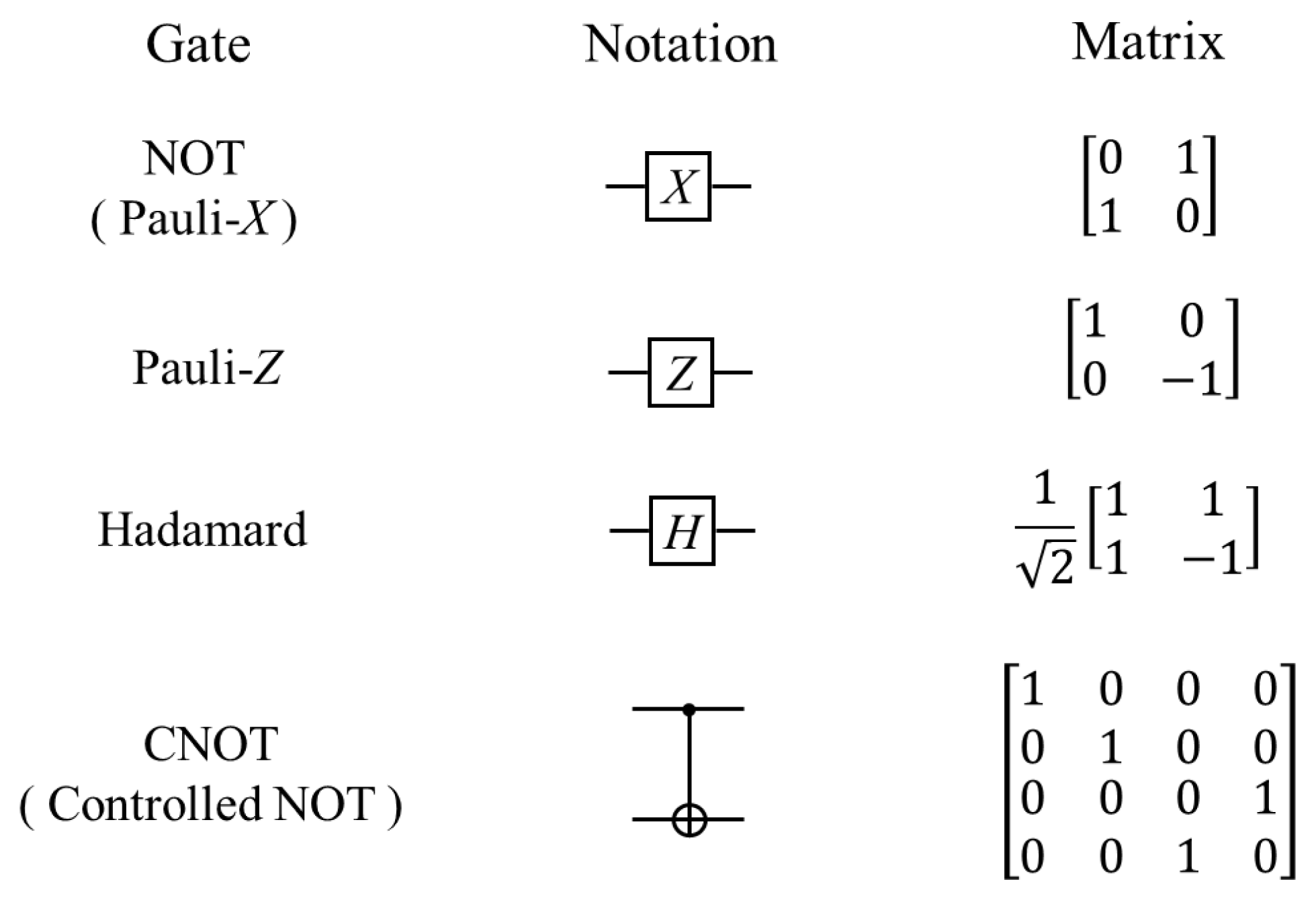
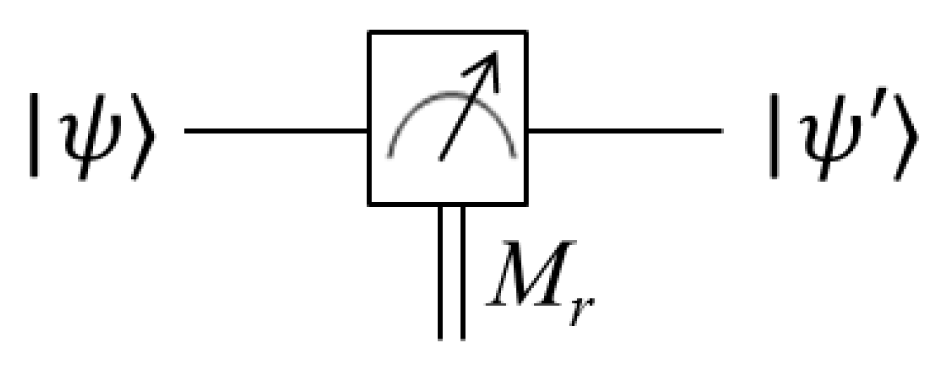



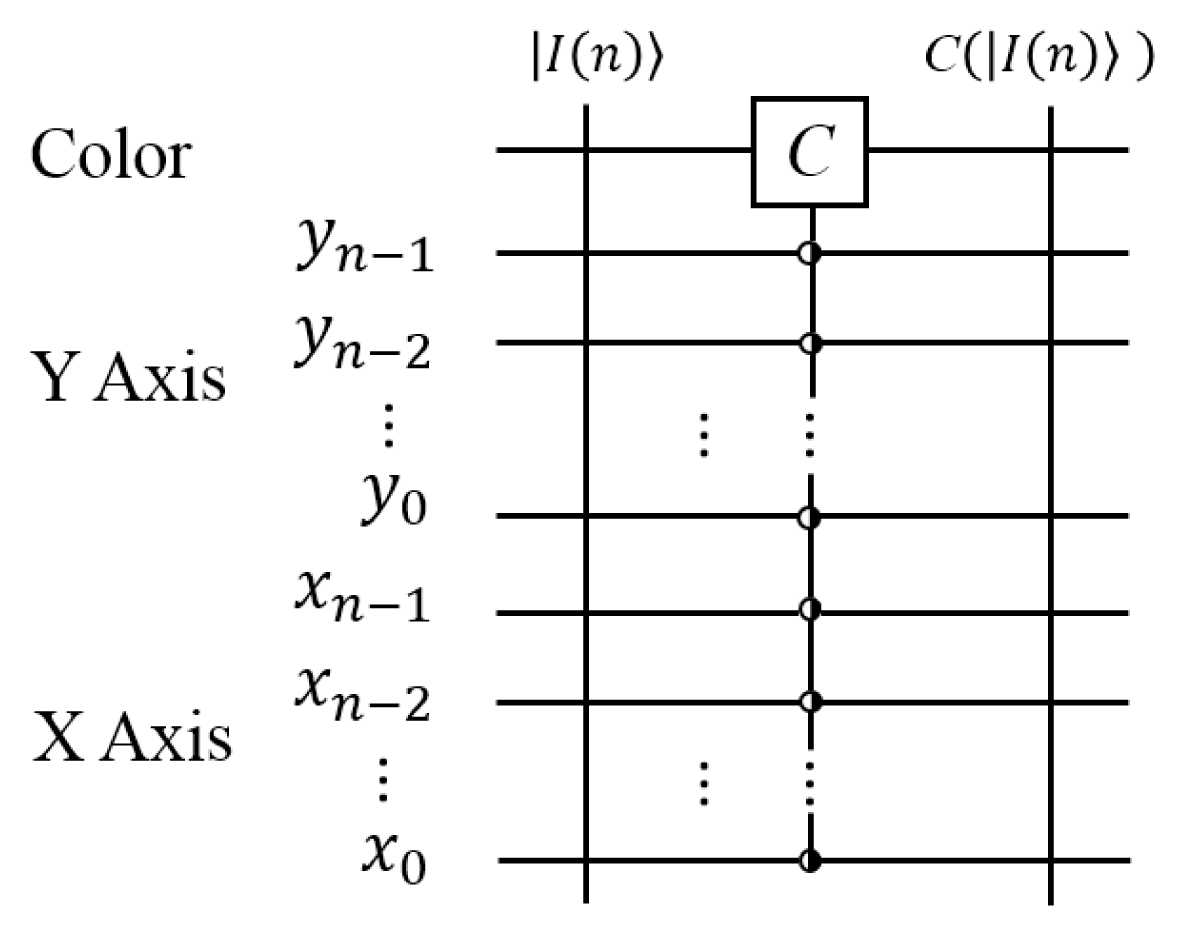
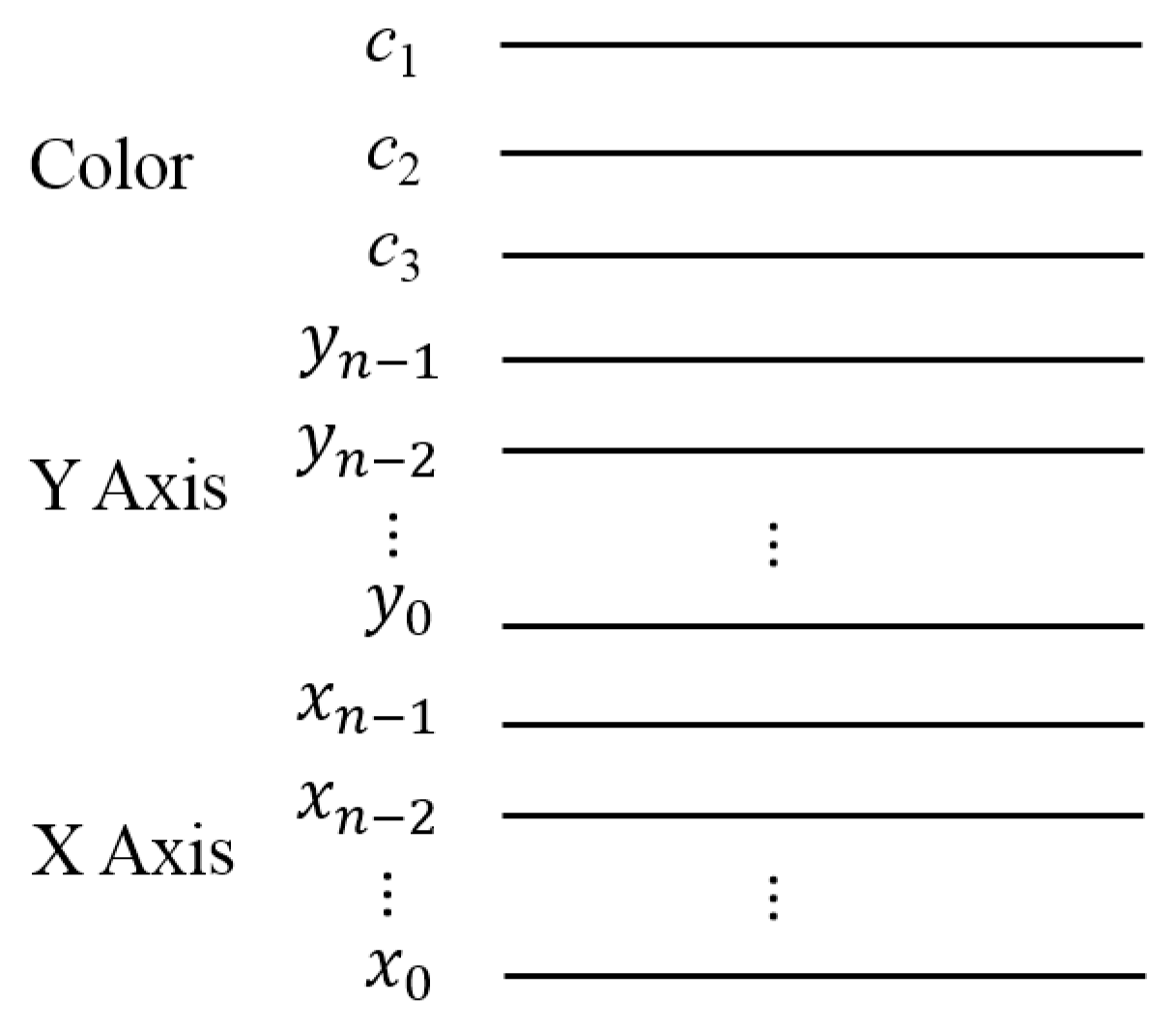
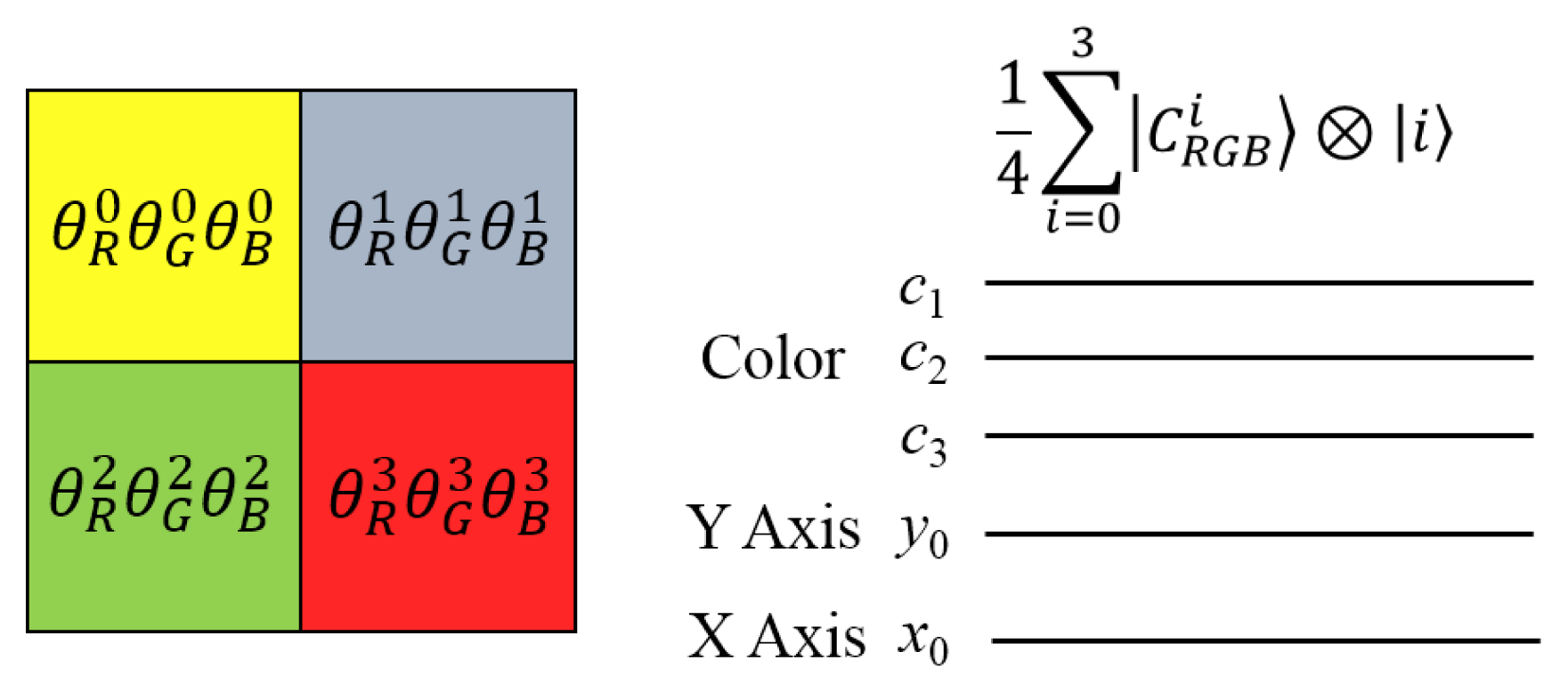




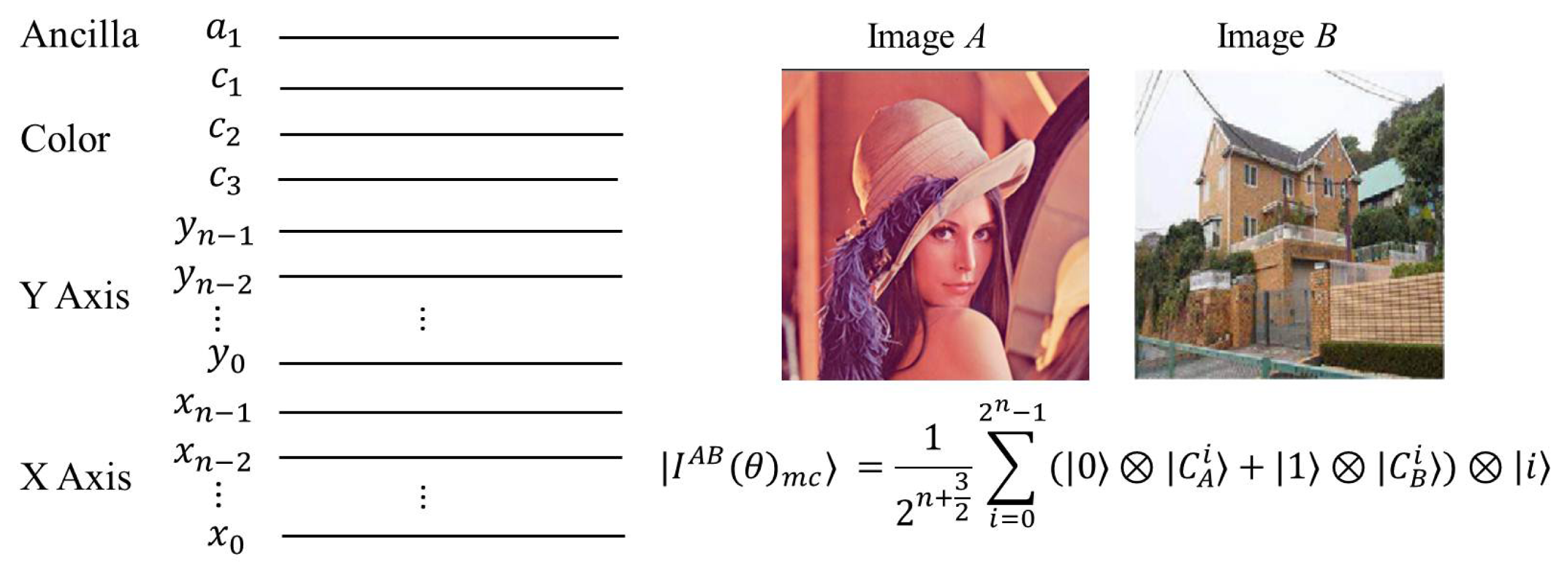
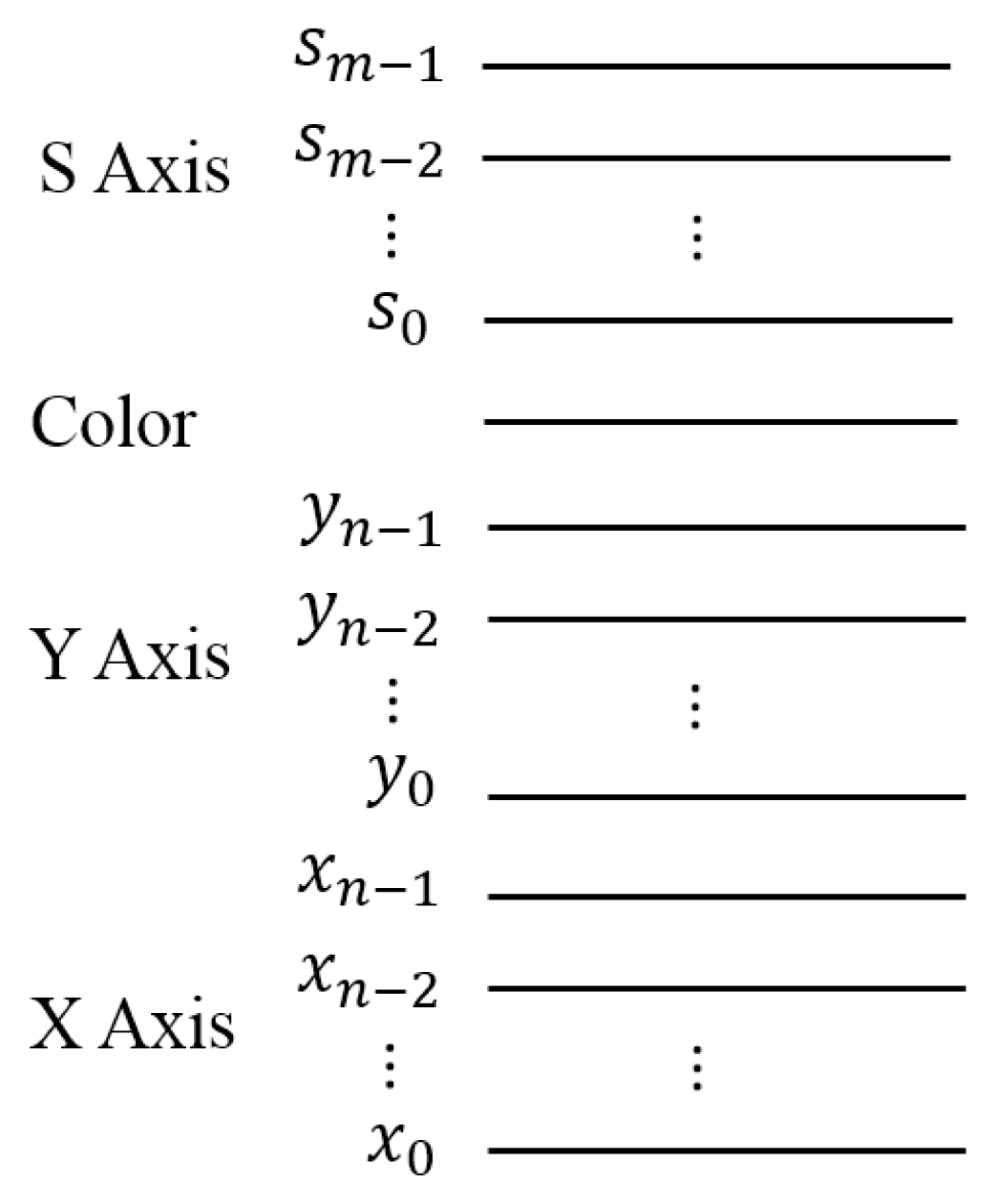
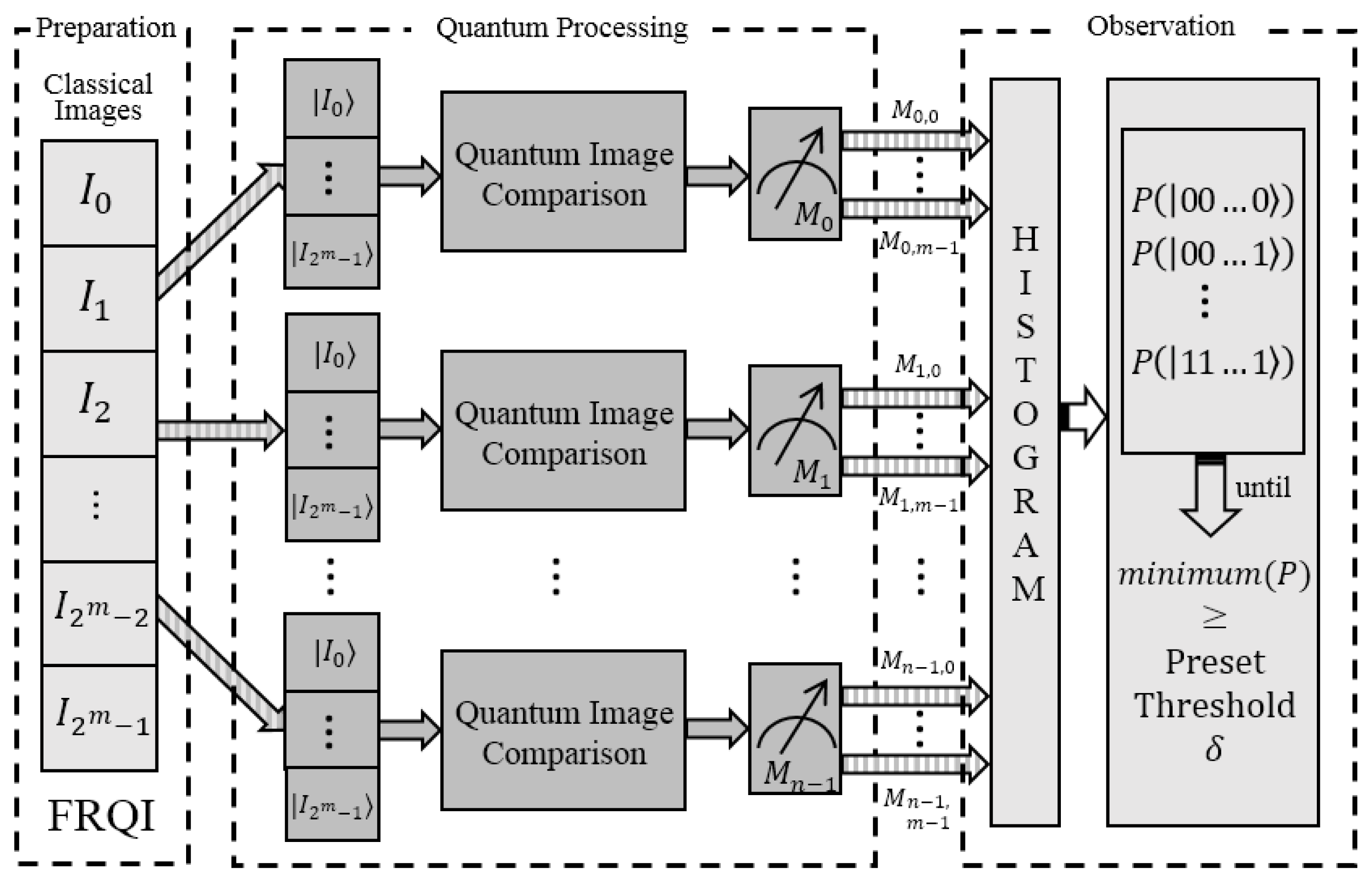
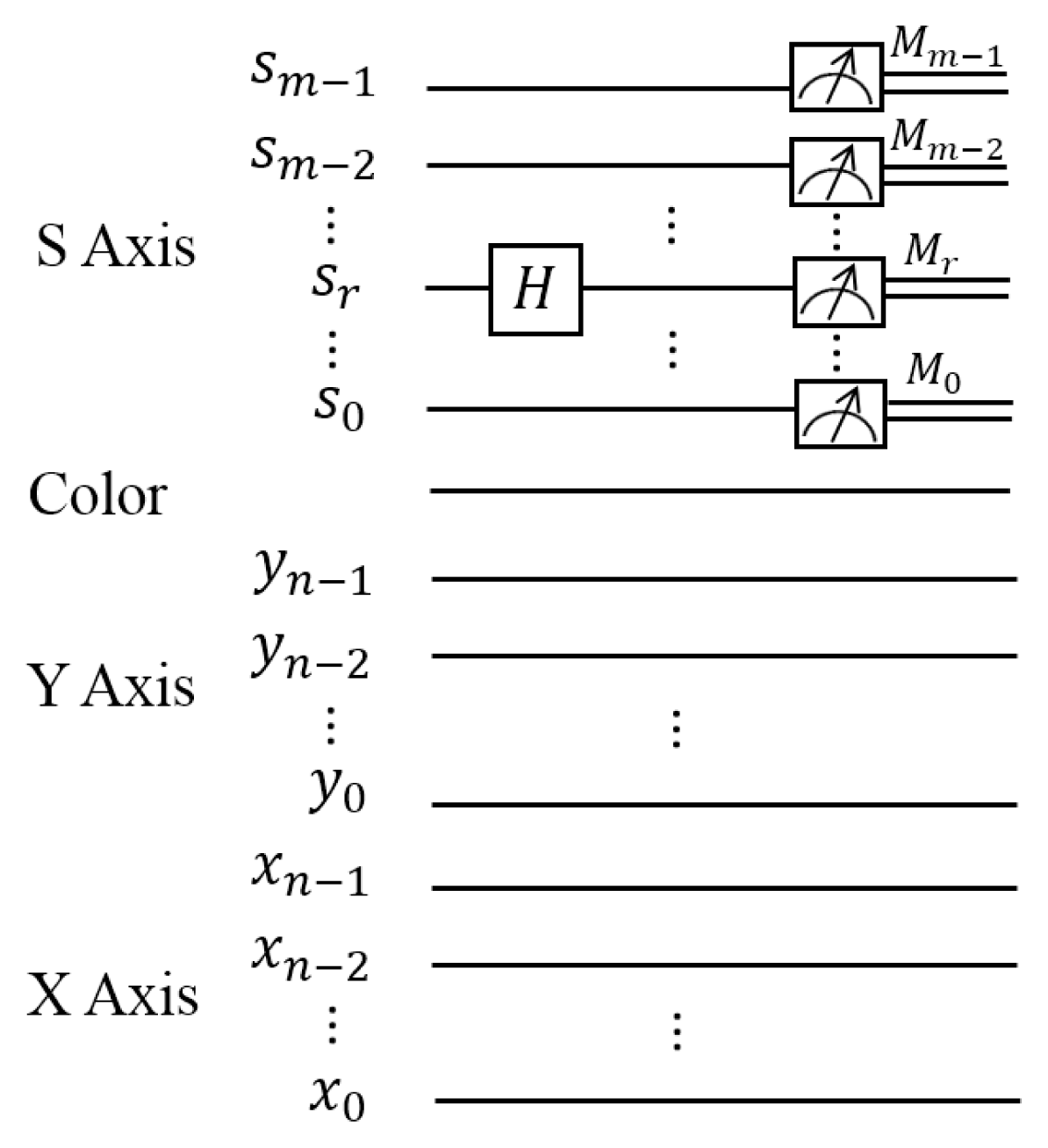

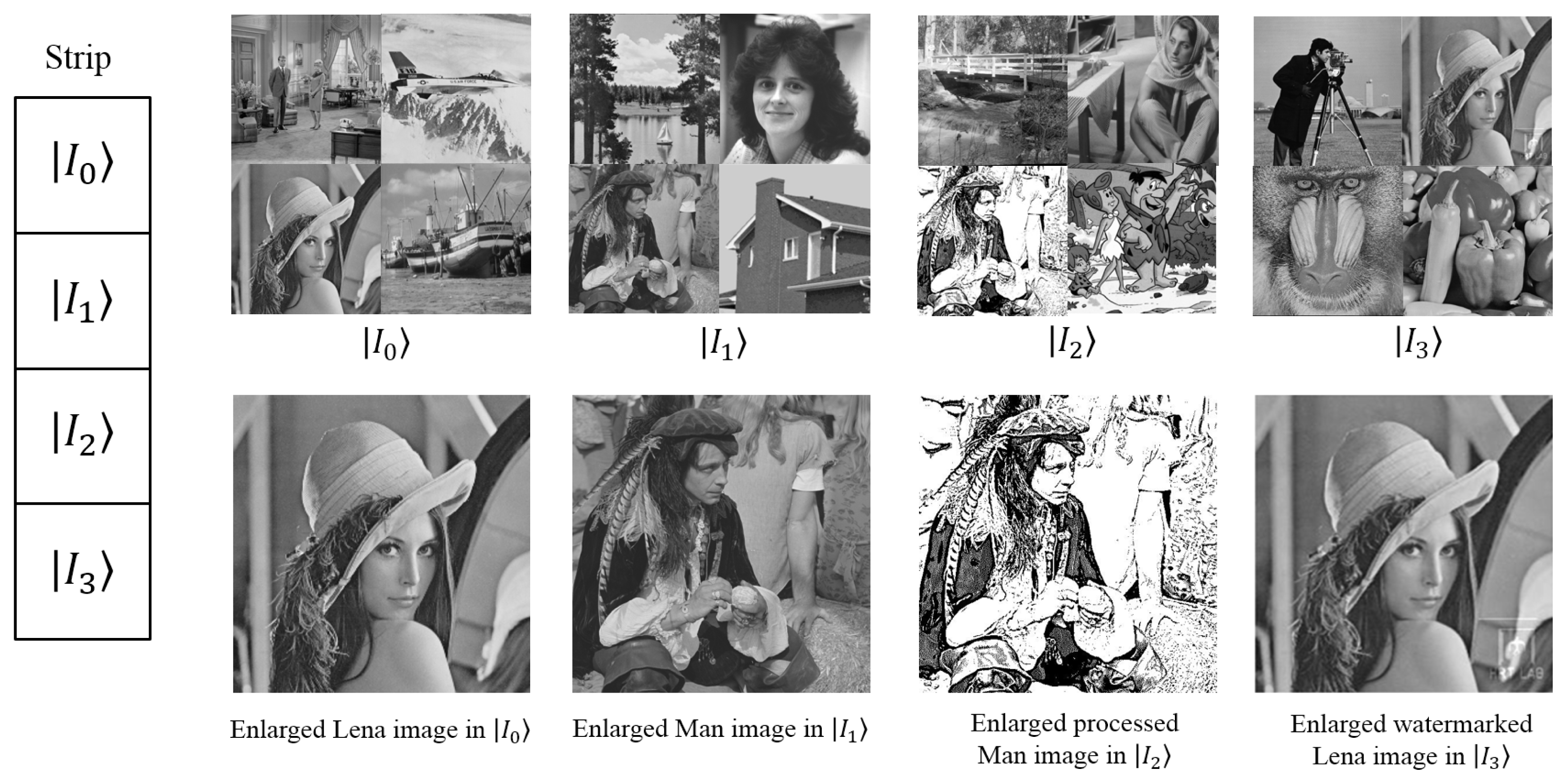
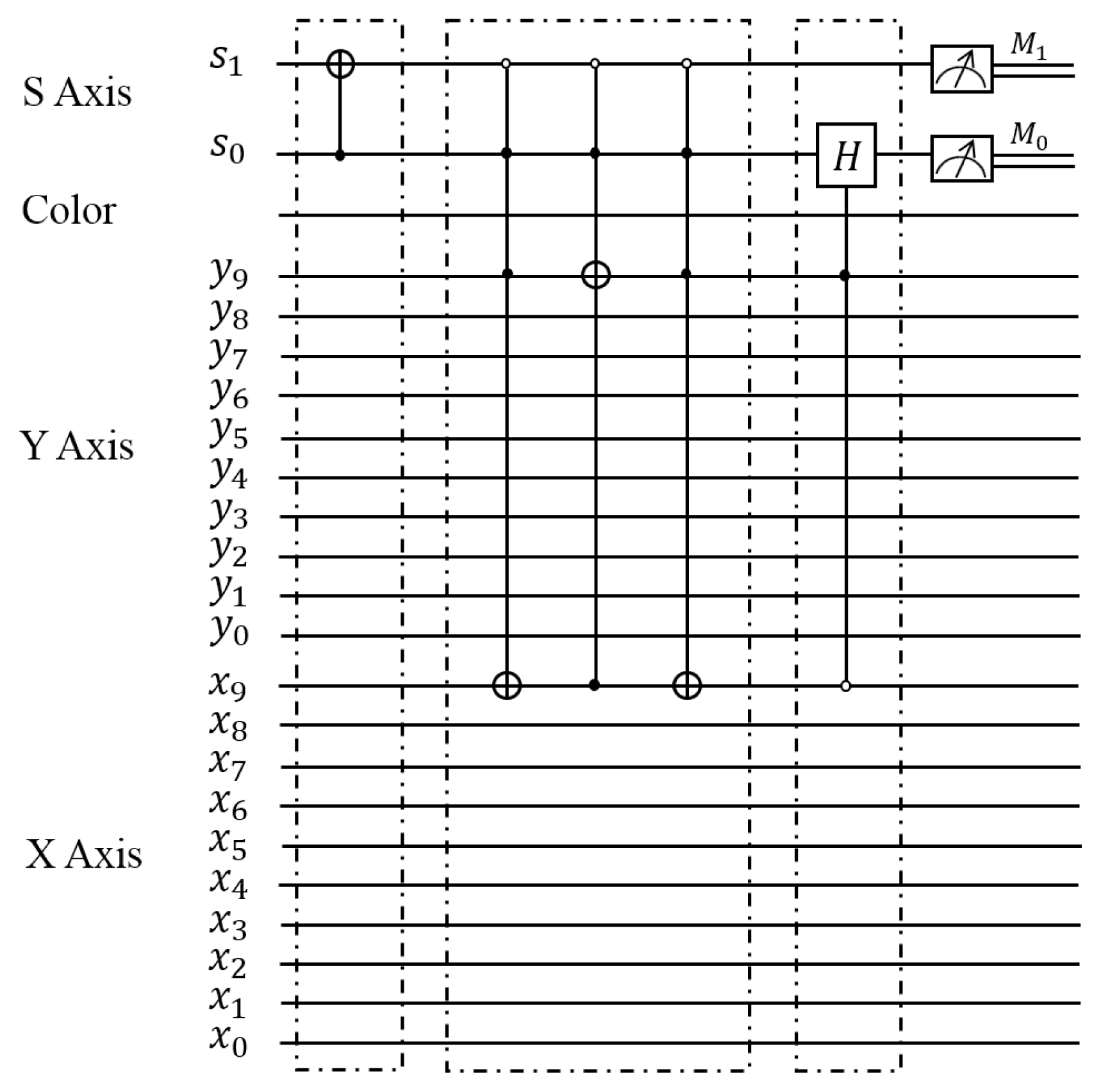
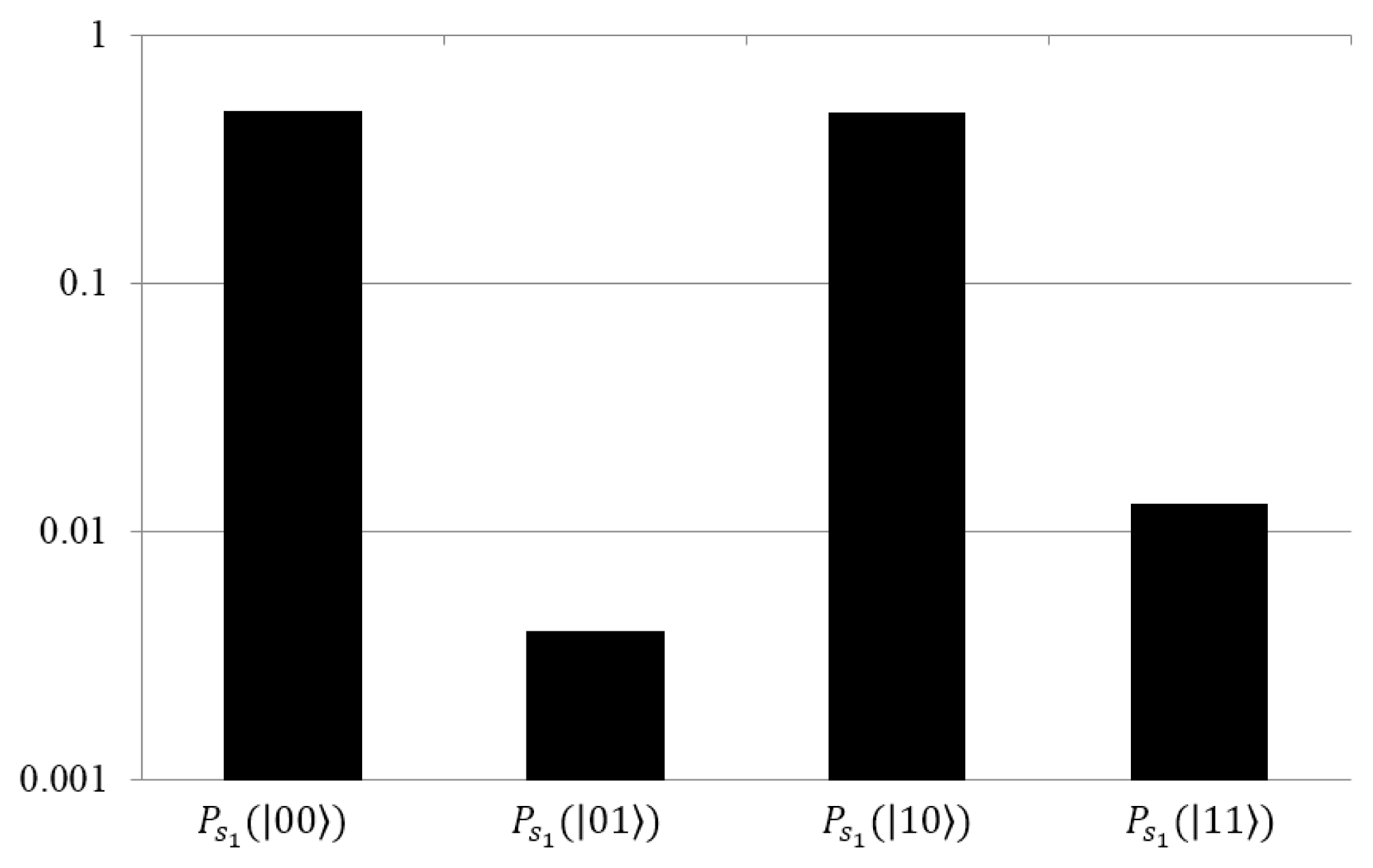

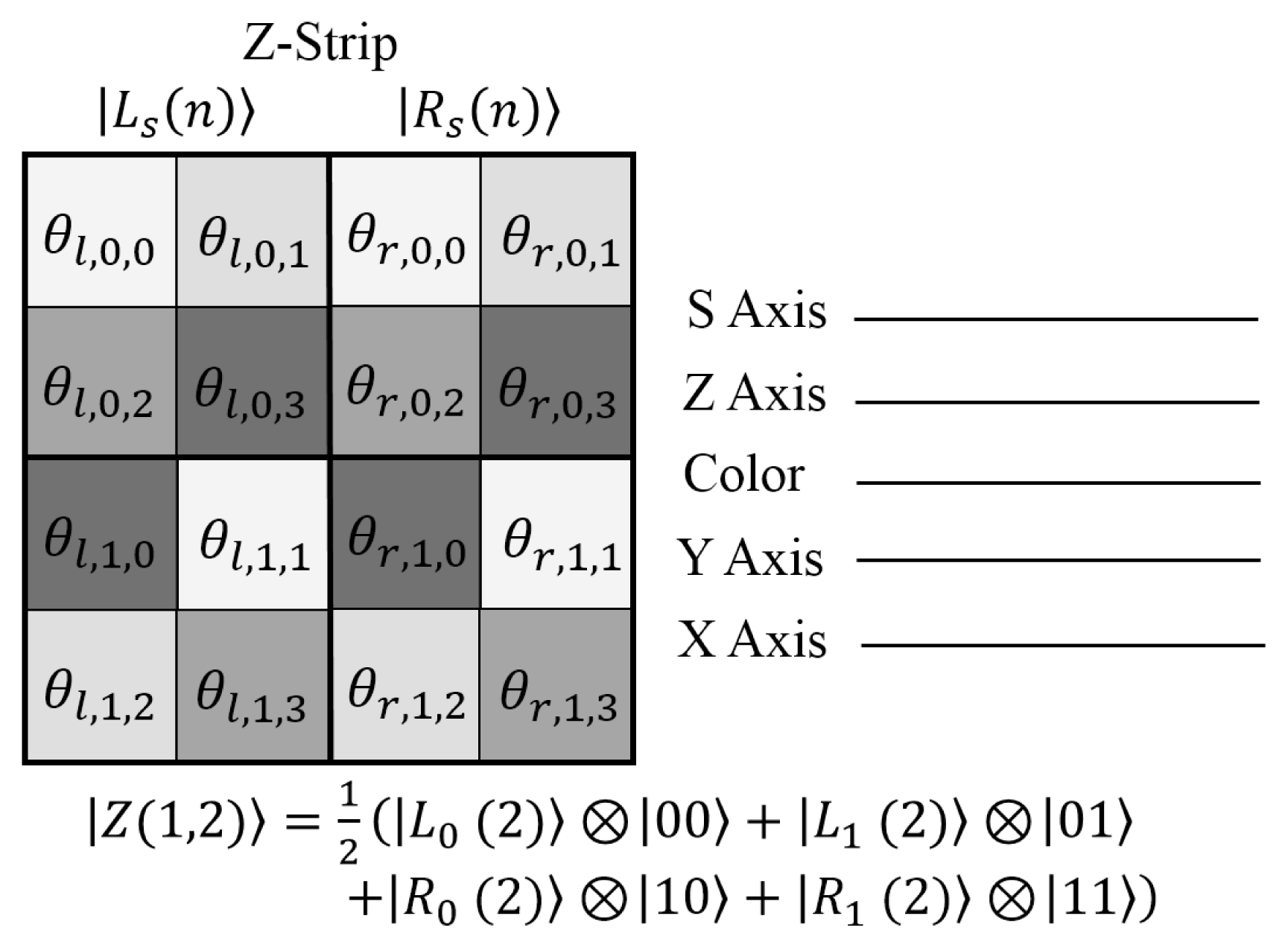
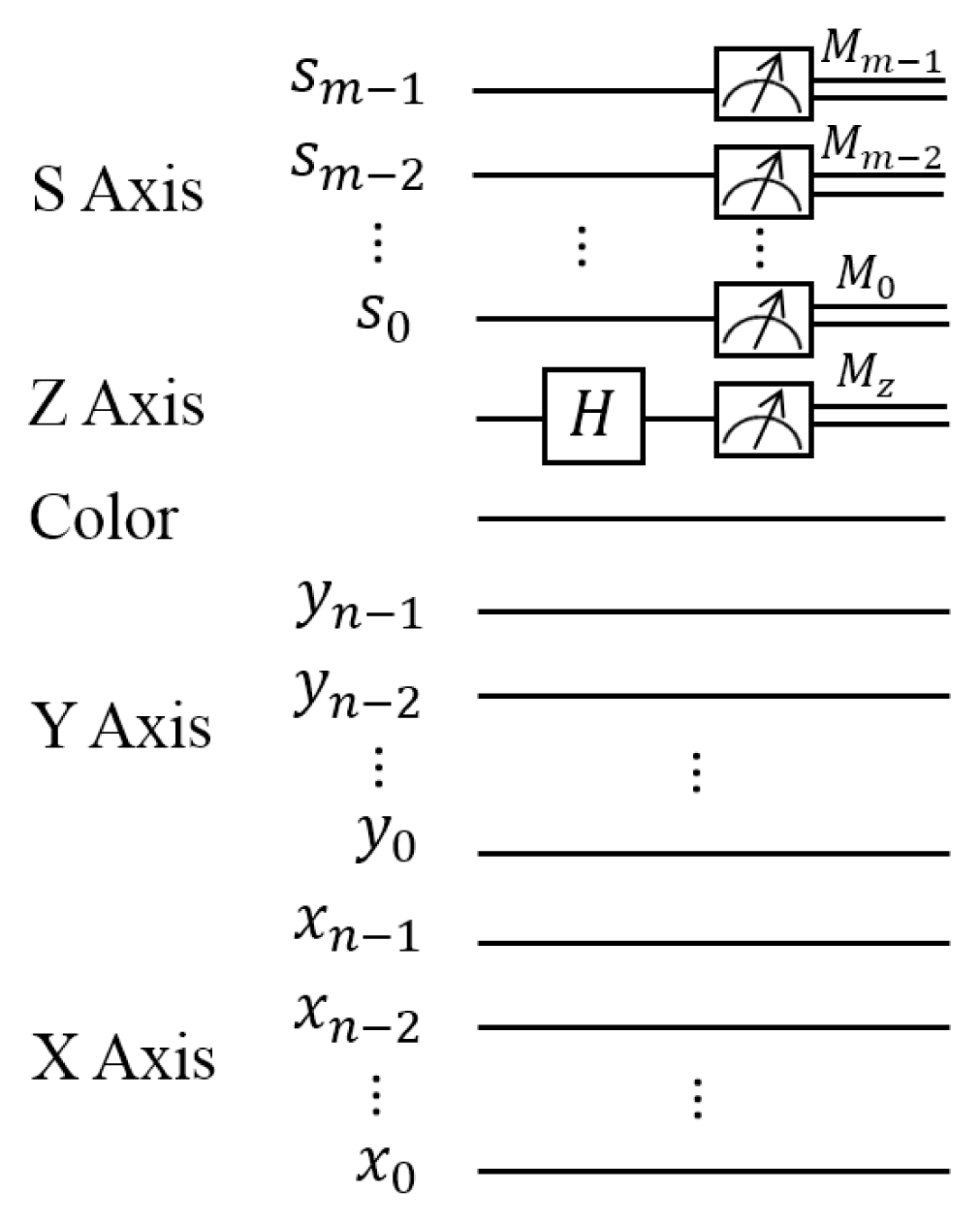

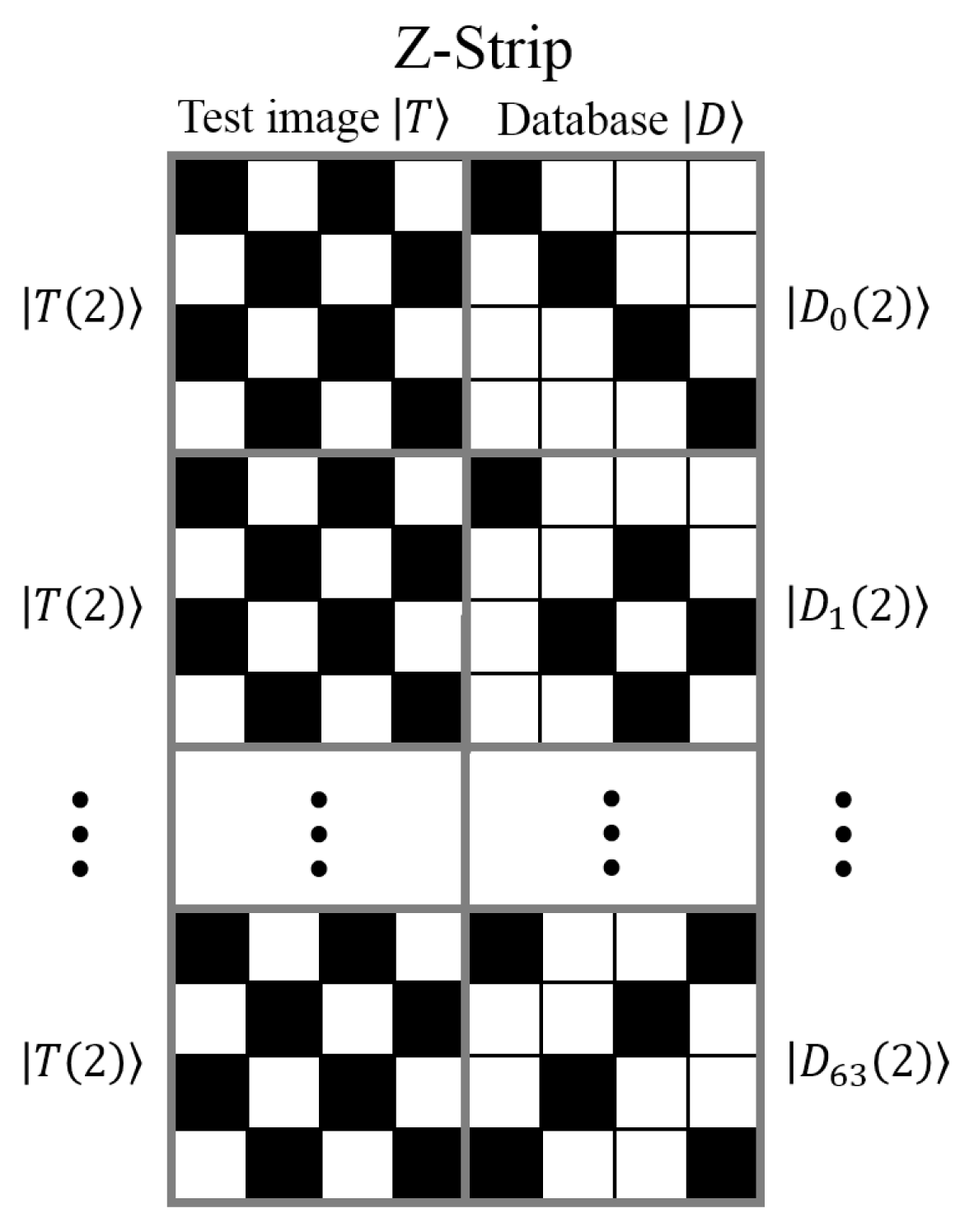
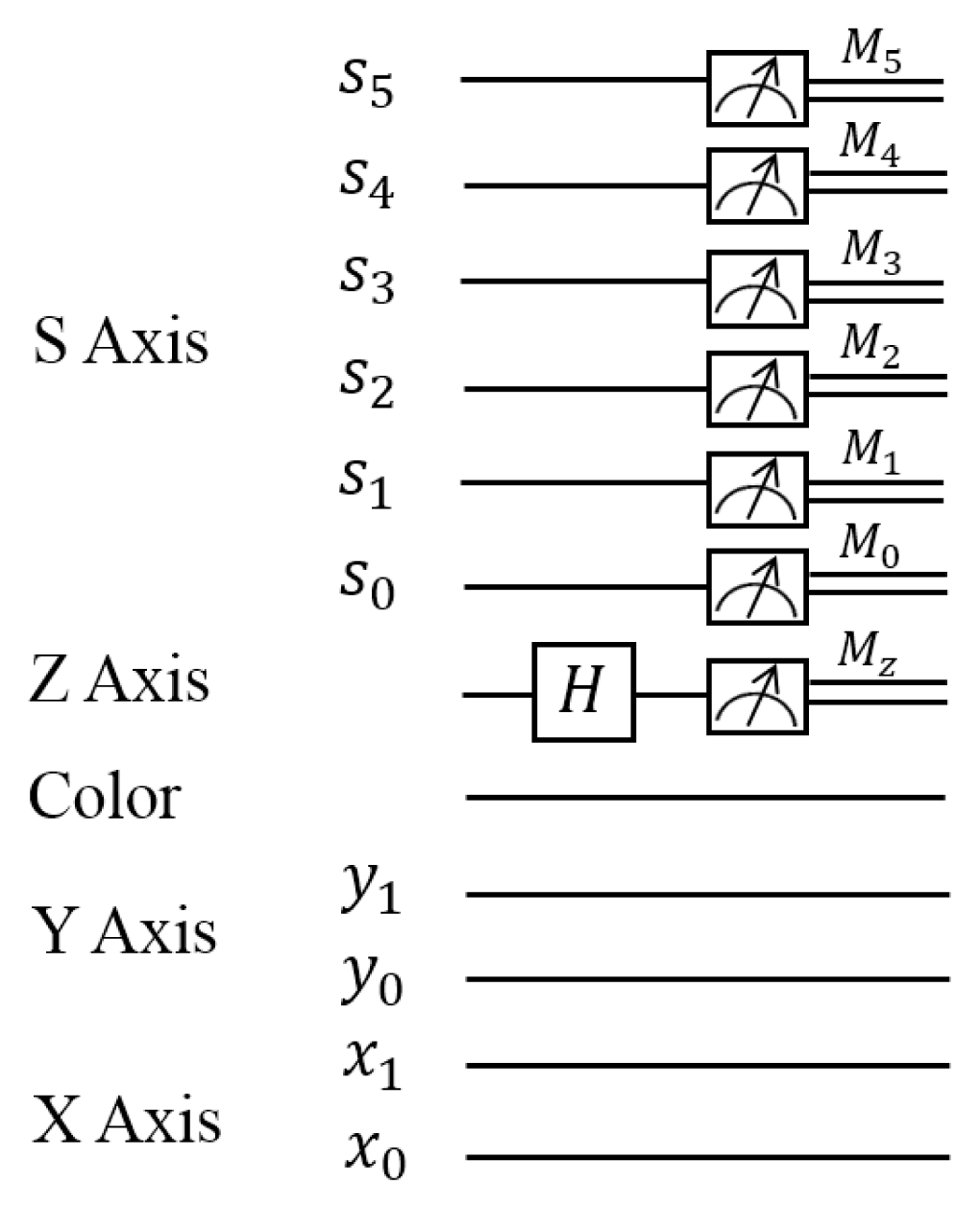
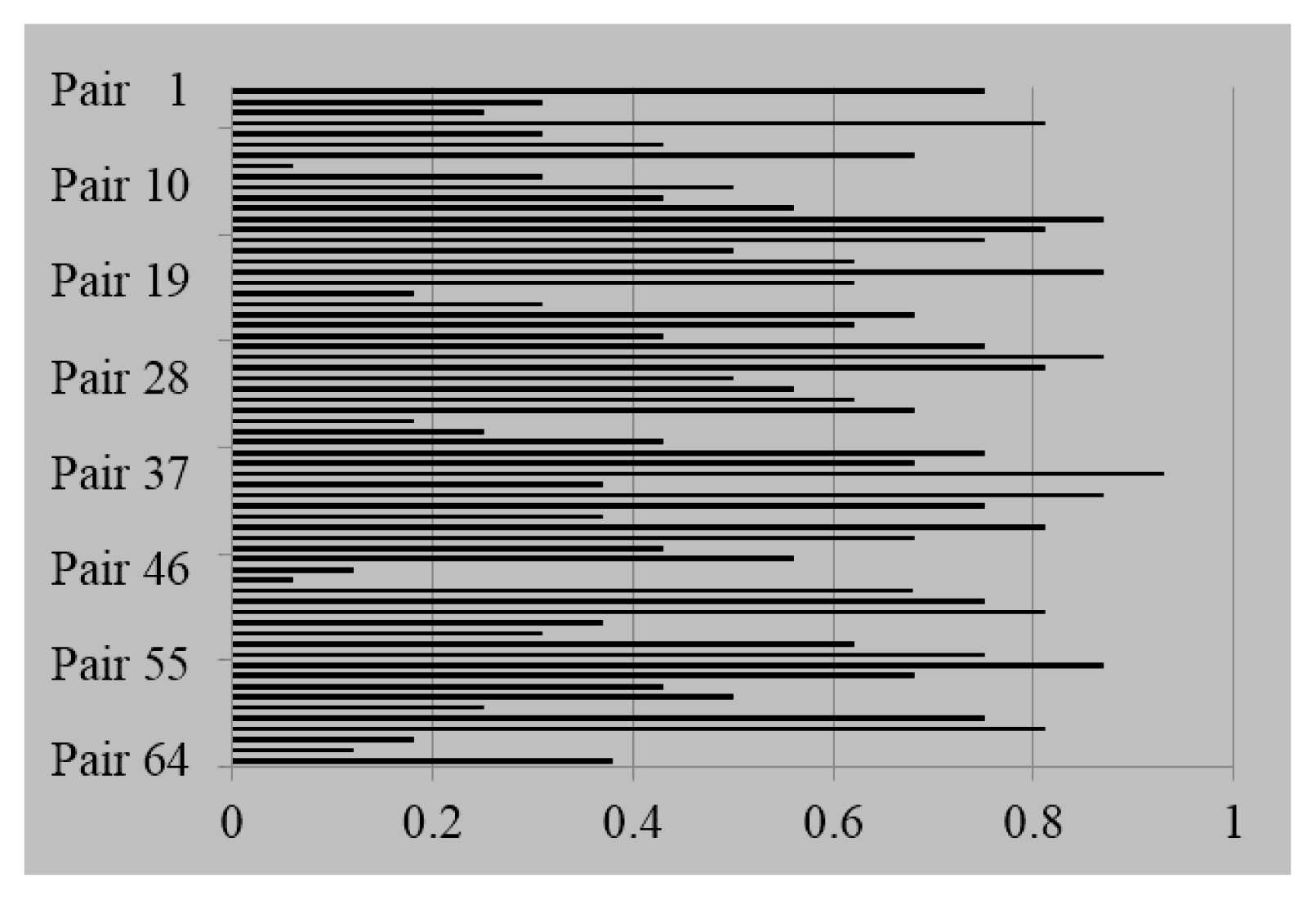
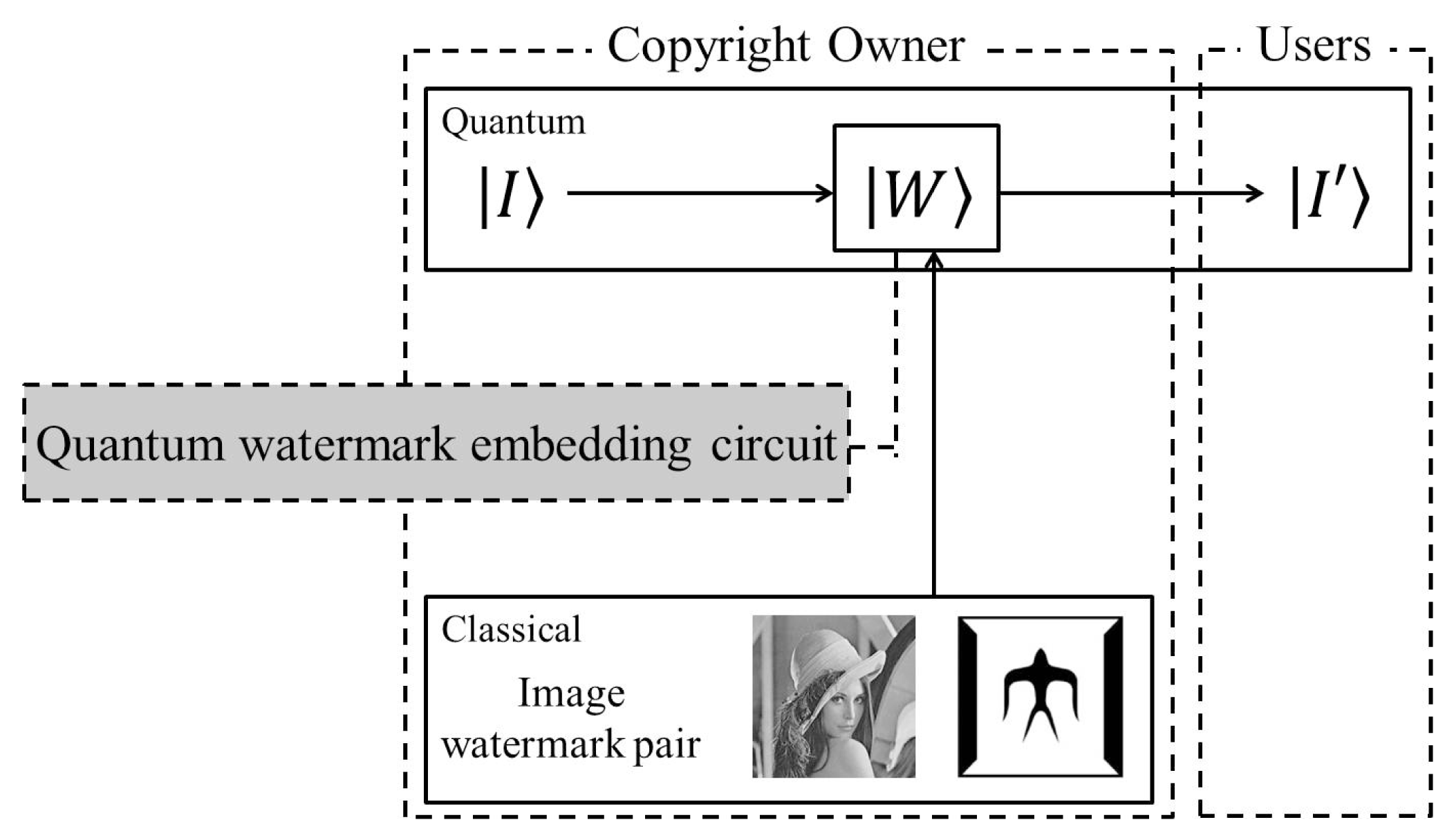
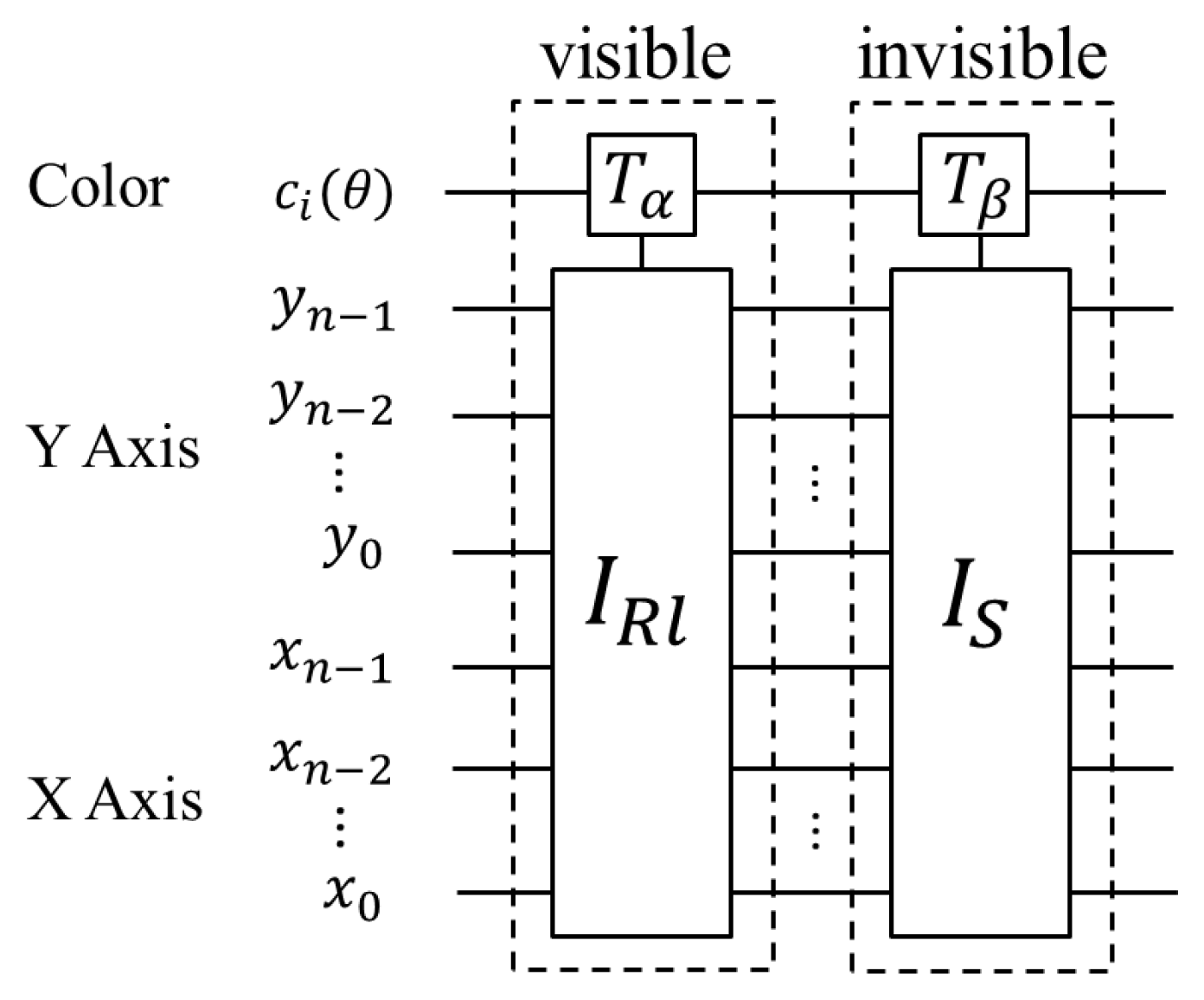
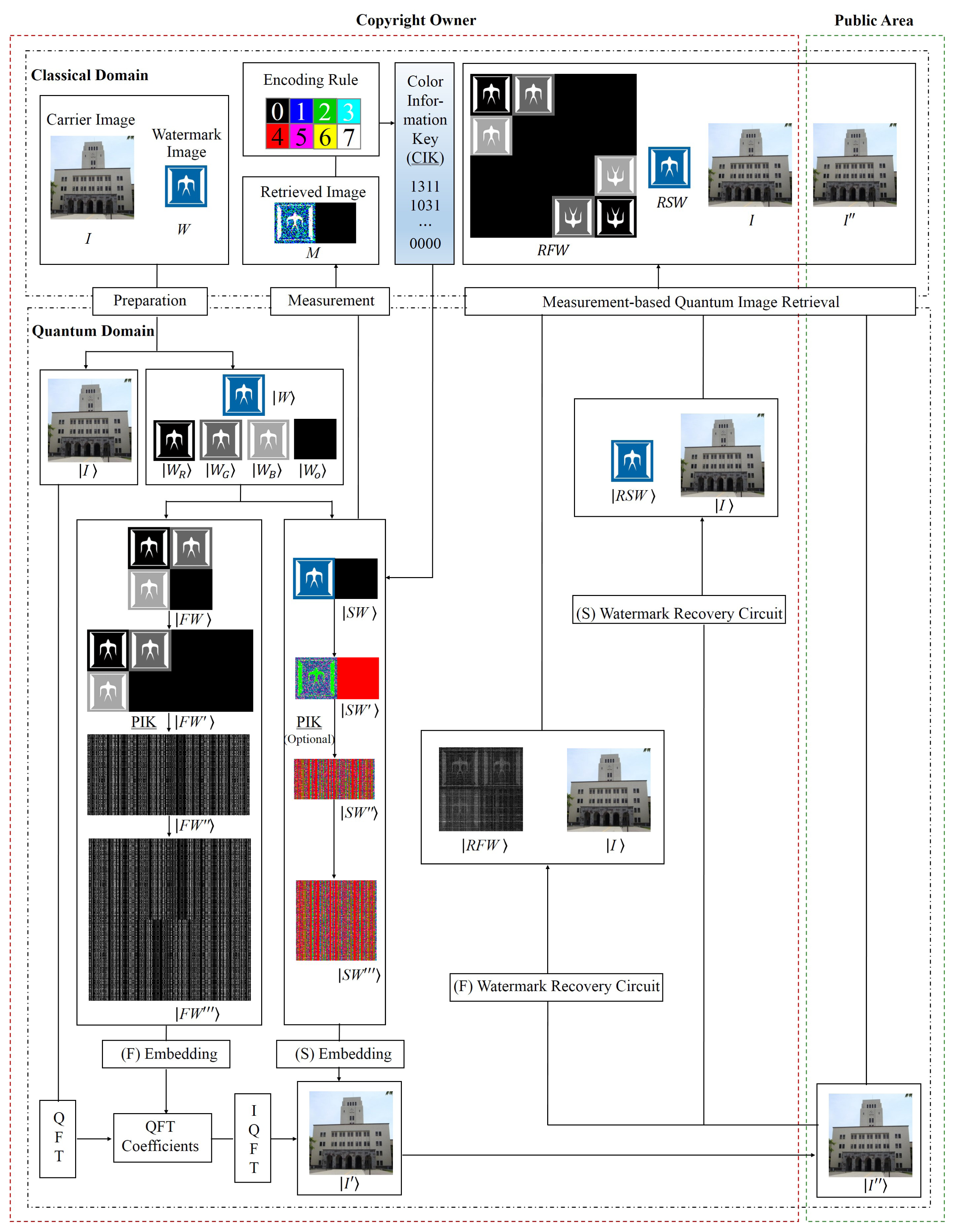

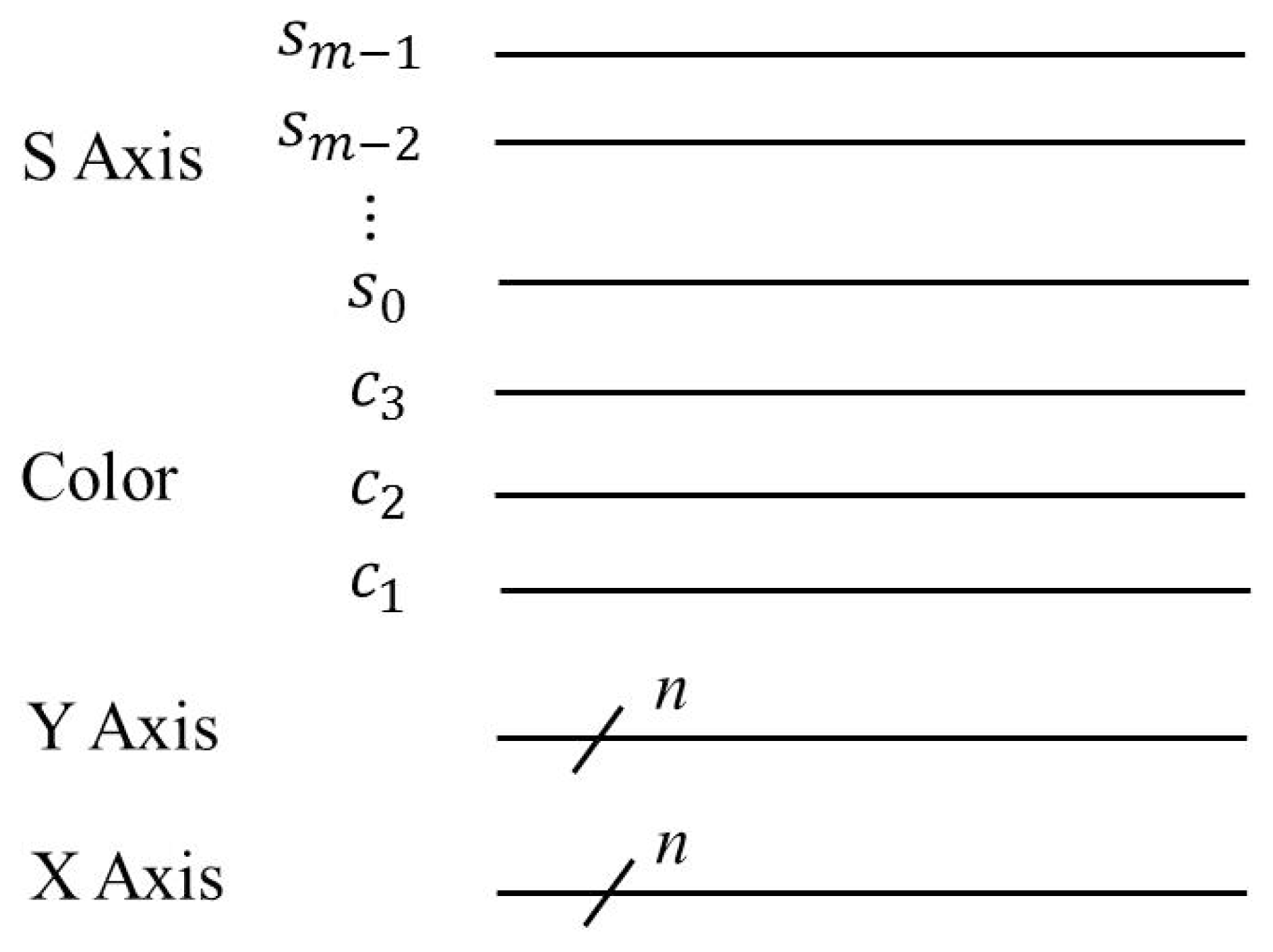


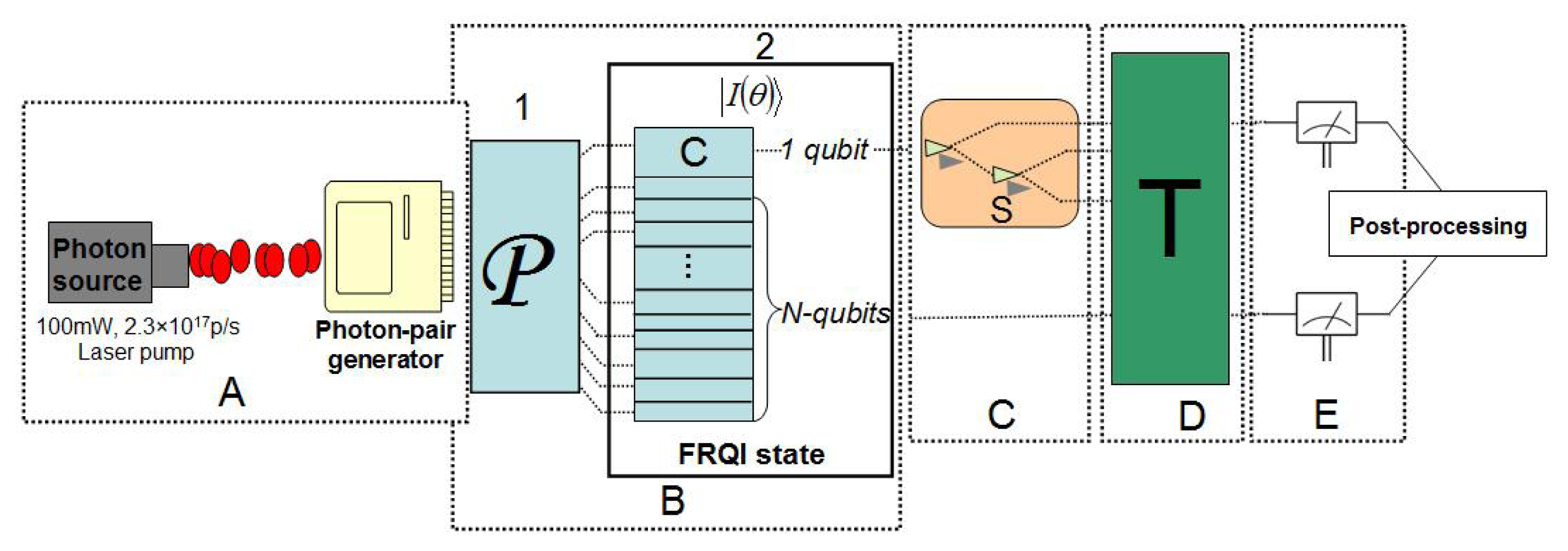

| Image Comparison | Probability | Similarity |
|---|---|---|
| Ps0 (|01〉) = 0.004 | sim(|i0〉, |i3〉) = 0.936 | |
| Ps0 (|11〉) = 0.013 | sim(|i1〉, |i2〉) = 0.787 |
© 2014 by the authors; licensee MDPI, Basel, Switzerland This article is an open access article distributed under the terms and conditions of the Creative Commons Attribution license (http://creativecommons.org/licenses/by/3.0/).
Share and Cite
Yan, F.; Iliyasu, A.M.; Jiang, Z. Quantum Computation-Based Image Representation, Processing Operations and Their Applications. Entropy 2014, 16, 5290-5338. https://doi.org/10.3390/e16105290
Yan F, Iliyasu AM, Jiang Z. Quantum Computation-Based Image Representation, Processing Operations and Their Applications. Entropy. 2014; 16(10):5290-5338. https://doi.org/10.3390/e16105290
Chicago/Turabian StyleYan, Fei, Abdullah M. Iliyasu, and Zhengang Jiang. 2014. "Quantum Computation-Based Image Representation, Processing Operations and Their Applications" Entropy 16, no. 10: 5290-5338. https://doi.org/10.3390/e16105290




